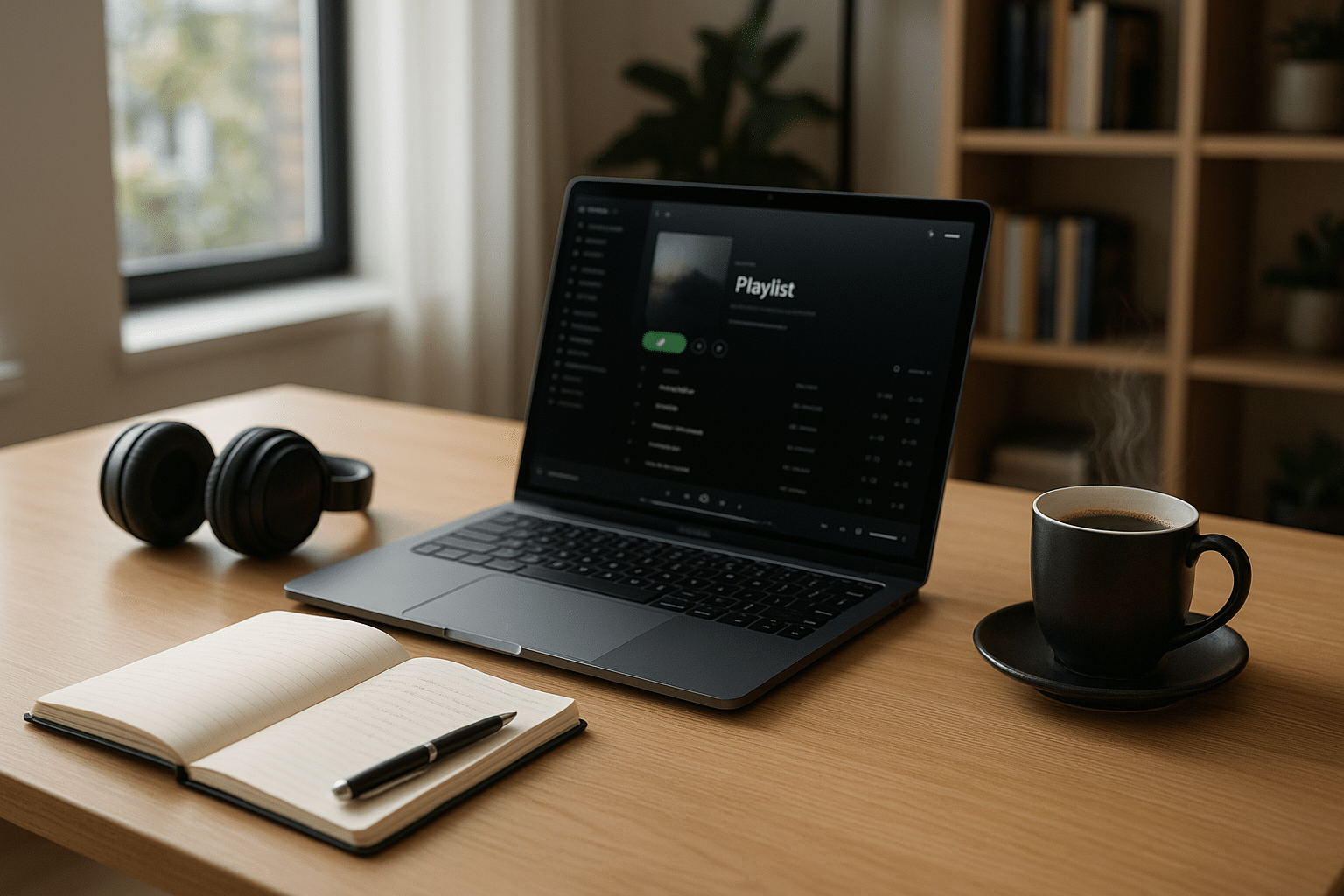Imagine a scene: it’s a regular weekday morning, you’re at your workspace, your to-do list stretches out before you, and the mental gears are already whirring. The question is – how can you keep your focus sharp, productivity high, and creative juices flowing? 🎧 The answer might surprise you – a custom focus playlist!🎵
Music, with its boundless power to inspire, motivate, and influence our moods, could be your secret weapon in the battle against distractions and productivity slumps. In this comprehensive guide, we’ll explore the fascinating link between music and productivity, and reveal how you can harness the power of a custom focus playlist to boost your performance and maintain your concentration.
Why Music?
From the soothing strains of classical music to the rhythmic beats of techno, music has a profound effect on our brains. It has the power to invoke emotions, trigger memories, and even manipulate our perceived passage of time. But what’s even more interesting is the scientific evidence showing that music can directly impact our cognitive processes, improving focus, boosting productivity, and enhancing creativity.
The Power of a Custom Focus Playlist
While music’s impact on productivity is no secret, the concept of a ‘focus playlist’ might be new to some of you. Essentially, a focus playlist is a collection of songs specifically selected to facilitate concentration and boost productivity. But it’s not just about plugging in your headphones and hitting ‘shuffle’. 🎼 A successful focus playlist requires careful consideration of your personal preferences, work tasks, and even your environment.
What’s Ahead?
In this blog post, we’ll take a deep dive into the power of music and how you can harness it to create your custom focus playlist. We’ll start by exploring the science behind music and productivity, discussing the brain-music connection and how it affects your work performance. From there, we’ll delve into the components of an effective focus playlist, considering the influence of genres, rhythms, tempos, and lyrics. 📝 We’ll also provide you with practical tips and tools for curating your own focus playlist, helping you find the ‘soundtrack’ to your workday that will take your productivity to new heights.
Unlock Your Potential
Whether you’re a fan of classical symphonies, love the energy of electronic music, or prefer the relaxing sounds of nature, this guide will help you understand how to use music as a tool for productivity. No longer just a background noise, music becomes a strategic ally, a productivity booster that can help you tap into your brain’s potential and unlock new levels of focus and efficiency.
Ready to conquer your workday with the power of a custom focus playlist?🎵 Let’s dive in and discover the science, strategies, and secrets of music that works for you.
Unlock Your Potential: Harness the Power of a Custom Focus Playlist
Music has an incredible ability to influence our mood, productivity, and even learning capabilities. In the realm of productivity, a well-crafted custom focus playlist can be a game-changer. The power of music that works in sync with your brain’s rhythms can significantly enhance your focus and productivity. But how does this work exactly? And how can you create your own focus playlist? Let’s dive in.
In this article, we will look into the scientific rationale behind the effectiveness of music in boosting productivity, steps to create your own custom focus playlist, and a comparative analysis of various music platforms you can use. I encourage you to take this journey with me as we unveil the wonders of music and its impact on our productivity. Don’t forget to watch the video, “Music for Concentration, Study, Work – 8 Hours of Productive Music” by Brainwave Power Music, which perfectly embodies the principles we’ll discuss.
The Science Behind Music and Productivity
It’s no secret that music has profound effects on our mood and cognitive functions. The underpinnings of this relationship can be traced back to how our brain interacts with different kinds of music. Neuroscience reveals that the right kind of music can enhance our focus, increase our mood, and boost productivity.
Let’s delve into the science behind it. The human brain operates on different frequencies depending on our state of mind. For example, when we are relaxed and calm, our brain emits Alpha waves. On the other hand, when we are focused and engaged in a task, our brain emits Beta waves. Music, specifically music with a BPM (beats per minute) that matches our intended brain wave state, can help us shift into that state more easily. For example, listening to music with a BPM of 60-70 can help promote concentration and focus.
Now, how does this relate to productivity? Music that is tailored to your brain’s rhythms can help you stay focused on the task at hand, reduce distractions, and ultimately boost your productivity. To understand this better, let’s look at a comparative table that shows the impact of different types of music on productivity.
| Type of Music | Effect on Productivity |
|---|---|
| Classical Music | Known to reduce stress and improve mood, which can lead to increased productivity. |
| Nature Sounds | Helps to create a calm environment, reducing distractions and promoting focus. |
| Binaural Beats | Helps to synchronize brainwaves to a desired frequency, promoting focus and concentration. |
Creating Your Own Focus Playlist
Now that we have understood the scientific basis of music’s influence on productivity, let’s dive into the process of creating your own custom focus playlist. This is a personal journey that requires understanding your own preferences, work habits, and the types of tasks you perform.
Start by identifying the types of music that help you concentrate. This could be anything from classical music to nature sounds, or even ambient electronic music. The key is to select music that doesn’t distract you from your tasks. Instrumental music or songs in a language you don’t understand can be particularly effective as they prevent your brain from focusing on lyrics.
Next, consider the complexity of the task at hand. Different tasks require different levels of cognitive engagement. For complex tasks that require deep focus, opt for simple, repetitive background music. For simpler, more mundane tasks, you may find that more complex music keeps you engaged and makes the task more enjoyable.
Choosing the Right Music Platform
Once you have an idea of what type of music works best for you, the next step is to find a music platform that suits your needs. There are numerous platforms out there, each with their own unique features. To make the process easier, let’s compare some popular music platforms:
| Music Platform | Pros | Cons |
|---|---|---|
| Spotify | Personalized playlists, wide variety of music | Requires subscription for ad-free listening |
| Apple Music | High-quality audio, wide music library | Limited personalization options, requires subscription |
| YouTube | Free, wide variety of music and sounds | Advertisements, not primarily a music platform |
When choosing a platform, consider factors such as cost, sound quality, and the variety of music available.
Maximize Your Productivity Today
Music is a powerful tool that can help enhance our focus and productivity. The key is to select the right kind of music that aligns with your personal preferences and the nature of the tasks at hand. By understanding the science behind music and productivity and by creating your own custom focus playlist, you can leverage the power of music to significantly boost your productivity. Check out this YouTube video from Brainwave Power Music, titled “Music for Concentration, Study, Work – 8 Hours of Productive Music,” to start your productivity-boosting journey today.

Conclusion
In wrapping up this comprehensive article, it is only fitting that we take a moment to reflect on the key insights we have gained. We have journeyed through the complex world of IT and software engineering, dissected intricate concepts, and emerged with a more profound understanding of this intriguing field.
From understanding the basics of programming languages like Java, Python, and C++, to delving into intricate aspects of software development life cycle (SDLC), we have cast a wide net, touching on a multitude of aspects that make up this dynamic realm. Our exploration has given us insights into the critical role of Data Structures and Algorithms, making it clear how essential they are in the efficient execution of tasks in the digital world.
We’ve also discussed the importance of cybersecurity, underlining its role in today’s digitized world and the need for individuals and organizations to prioritize this aspect in order to safeguard their valuable information. In doing so, we’ve explored the various threats that exist in the cyber world, as well as the preventive measures that can be implemented.
In the realm of software engineering, we’ve unraveled the significance of software testing, detailing the different types of testing techniques and the crucial role they play in ensuring software quality. This discourse has reiterated the fact that the success of any software greatly depends on its functionality and reliability, aspects that can only be guaranteed through rigorous testing.
As we conclude, I hope that this article has not only increased your knowledge base but has also sparked your interest in further exploration. The world of IT and software engineering is vast and dynamic, and there’s always something new to learn.
Whether you are an aspiring programmer, a seasoned software engineer, or simply someone with a keen interest in understanding the inner workings of the digital world, I encourage you to dive deeper. Share your thoughts in the comments section, engage with others in the community, and continue expanding your knowledge horizon.
As a famous quote by Isaac Asimov goes, “The more you learn, the more you realize how much you don’t know.” So, let’s keep learning, keep growing, and keep exploring. 💡🌎💻
I’d like to express my gratitude to sources such as Stack Overflow, Codecademy, GitHub, and other technical forums and websites, for providing invaluable information and insights that greatly contributed to this article. Their active community of coders, software engineers, and IT enthusiasts is a testament to the power of shared knowledge and collective growth.
Thank you for joining me in this informative journey. As always, if there’s anything you’d like to add or clarify, don’t hesitate to reach out. Your engagement is not only welcomed but highly appreciated. Remember, knowledge is power, but only when shared. 🔗🔐💼
Reference Links:
1. Stack Overflow
2. Codecademy
3. GitHub
#SoftwareEngineering #IT #Cybersecurity #DataStructures #Algorithms #KeepLearning



